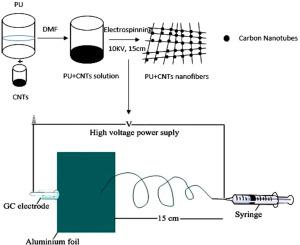Nano-Structures & Nano-Objects Pub Date : 2020-11-06 , DOI: 10.1016/j.nanoso.2020.100612 Mansab Ali Saleemi , Phelim Voon Chen Yong , Eng Hwa Wong

|
Carbon nanotubes (CNTs) are attractive materials because of their excellent physicochemical properties, electrical and thermal conductivity, mechanical strength, and chemical durability. Therefore, CNTs can be used in a wide range of various biological and pharmaceutical sectors. The impact of CNTs-fiber composites on the growth of microbial cells needs to be fully explored. In this work, we have investigated the antimicrobial role of thermoplastic polyurethane (TPU) nanofibers containing various concentrations of surfactant-modified CNTs, such as double-wall (DW) and multi-wall (MW) CNTs against different representative Gram-positive and Gram-negative bacterial and the fungal strains. Besides, the cytotoxic effects of synthesized nanofibers were also studied on the human adenocarcinomic lung epithelial cell line (A549). Various concentrations of surfactant-modified CNTs were prepared and then mixed with 10 % solution of polymer (TPU) in N, N-Dimethylformamide (DMF) solvent by using a magnetic stirrer. The prepared solution was passed through the electrospinning apparatus to obtain electrospun nanofibers using a highly stable dispersion. Fourier transform infrared spectroscopy (FTIR) results exhibited that polyurethane polymer was covalently attached to the sidewalls of functionalized CNTs. Further, the morphology of synthesized nanofibers and interaction between pathogens and TPU/f-CNTs fibers were studied by using a field-emission scanning electron microscope (FESEM), transmission electron microscope (TEM) and fluorescence microscopy. In conclusion, the highest rate of microbial growth inhibition was recorded when using the surfactant-modified CNTs concentration of 100 g/mL with 10 % TPU solution. The antimicrobial activity and cytotoxicity of TPU/f-CNTs nanofibers were both dependent on the treatment time and concentrations. The antimicrobial findings demonstrated the excellent microbicidal and prolonged microbial growth inhibition properties of electrospun nanofibers which propose their applicability as sustained antimicrobial biomaterials.
中文翻译:

合成的表面活性剂修饰的碳纳米管/聚氨酯电纺纳米纤维的抗菌活性和细胞毒性研究
碳纳米管(CNT)由于其出色的理化特性,电导率和导热率,机械强度以及化学耐久性而成为有吸引力的材料。因此,CNT可用于各种生物和制药领域。碳纳米管-纤维复合材料对微生物细胞生长的影响需要充分研究。在这项工作中,我们研究了包含各种浓度的表面活性剂改性的CNT(例如双壁(DW)和多壁(MW)CNT)的热塑性聚氨酯(TPU)纳米纤维对不同代表性的革兰氏阳性和革兰氏菌的抗菌作用。 -阴性细菌和真菌菌株。此外,还研究了合成纳米纤维对人腺癌肺上皮细胞系(A549)的细胞毒性作用。制备各种浓度的表面活性剂改性的CNT,然后通过使用磁力搅拌器将其与10%的聚合物(TPU)在N,N-二甲基甲酰胺(DMF)溶剂中的溶液混合。使所制备的溶液通过电纺丝设备,以使用高度稳定的分散体获得电纺丝纳米纤维。傅立叶变换红外光谱(FTIR)结果表明,聚氨酯聚合物共价连接到官能化CNT的侧壁上。此外,合成纳米纤维的形态以及病原体与TPU /之间的相互作用 制备的溶液通过电纺丝设备,以使用高度稳定的分散体获得电纺丝纳米纤维。傅立叶变换红外光谱(FTIR)结果表明,聚氨酯聚合物共价连接到官能化CNT的侧壁上。此外,合成纳米纤维的形态以及病原体与TPU /之间的相互作用 使所制备的溶液通过电纺丝设备,以使用高度稳定的分散体获得电纺丝纳米纤维。傅立叶变换红外光谱(FTIR)结果表明,聚氨酯聚合物共价连接到官能化CNT的侧壁上。此外,合成纳米纤维的形态以及病原体与TPU /之间的相互作用使用场发射扫描电子显微镜(FESEM),透射电子显微镜(TEM)和荧光显微镜研究了f -CNTs纤维。总之,当使用表面活性剂修饰的CNT浓度为100时,记录的最高微生物生长抑制率g / mL含10%TPU溶液 TPU / f -CNTs纳米纤维的抗菌活性和细胞毒性均取决于处理时间和浓度。抗菌研究结果表明,电纺纳米纤维具有优异的杀菌性能和延长的微生物生长抑制性能,这表明它们可作为持续的抗菌生物材料应用。











































 京公网安备 11010802027423号
京公网安备 11010802027423号